Strategic Management: Analysis of H&M's External Environment, Industry Sector, and Resources
VerifiedAdded on 2023/01/05
|7
|1805
|38
AI Summary
This assignment explores the strategic management of H&M, analyzing its external environment (PESTEL), industry sector (Porter's five forces), and resources and capabilities (VRIO). It examines the strengths, weaknesses, opportunities, and threats faced by H&M in the global market.
Contribute Materials
Your contribution can guide someone’s learning journey. Share your
documents today.
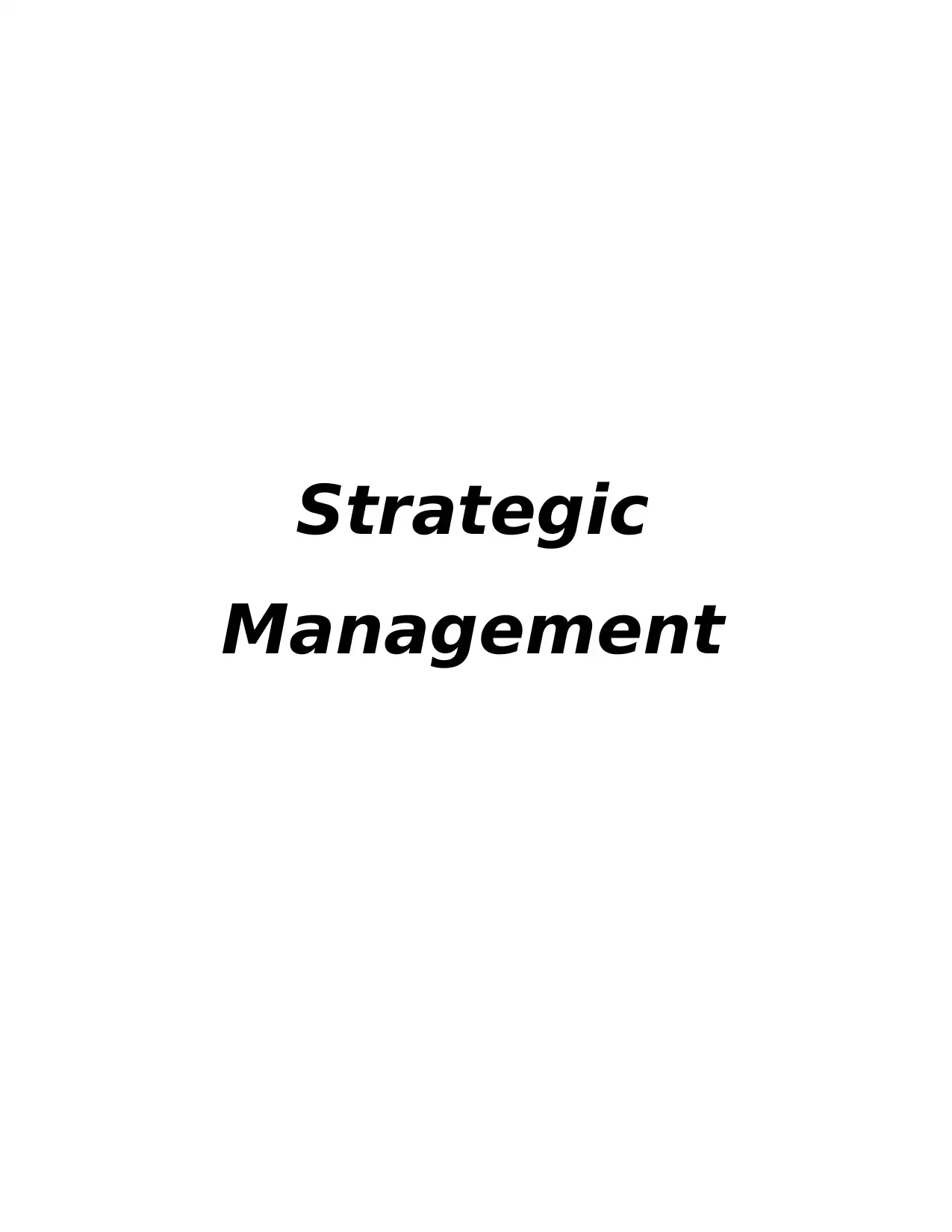
Strategic
Management
Management
Secure Best Marks with AI Grader
Need help grading? Try our AI Grader for instant feedback on your assignments.
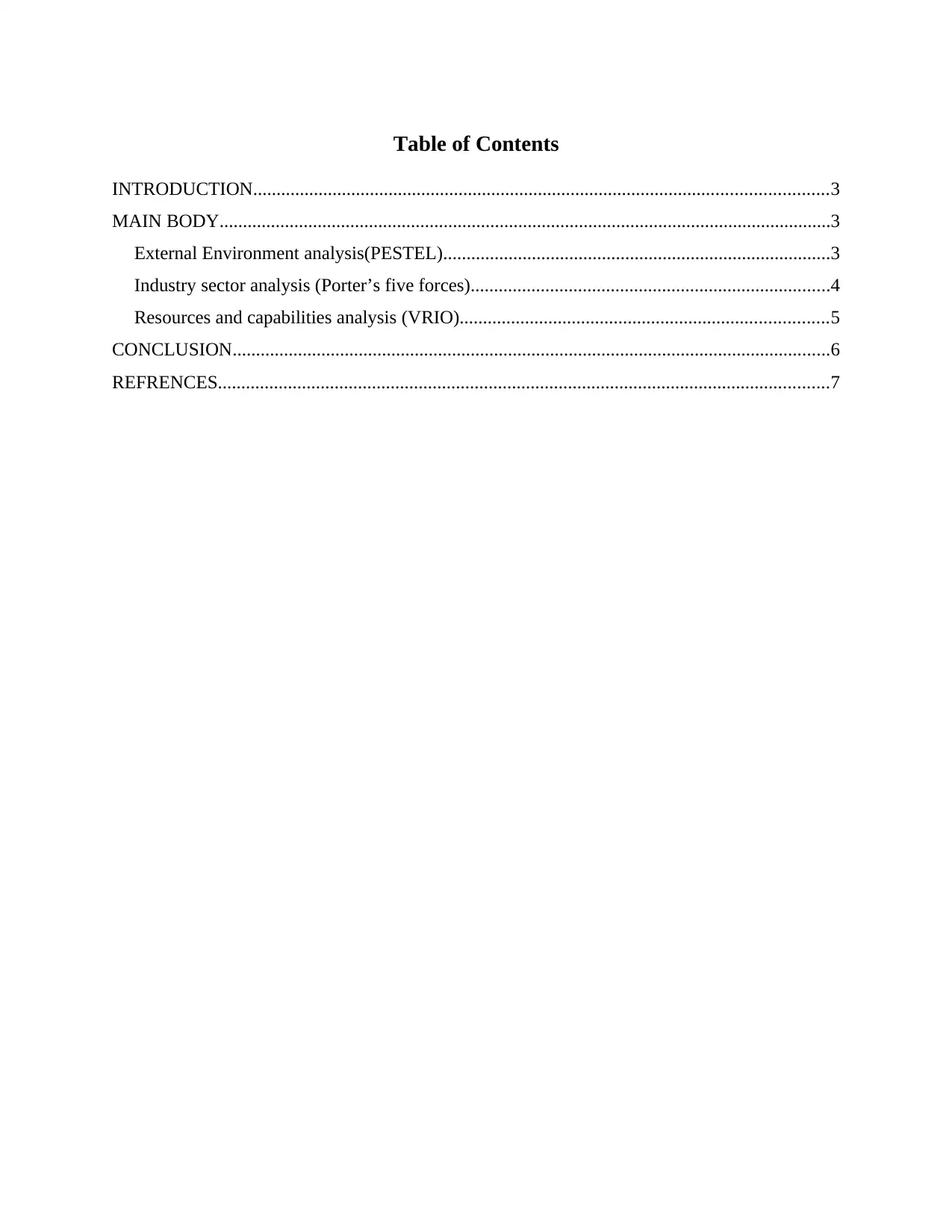
Table of Contents
INTRODUCTION...........................................................................................................................3
MAIN BODY...................................................................................................................................3
External Environment analysis(PESTEL)...................................................................................3
Industry sector analysis (Porter’s five forces).............................................................................4
Resources and capabilities analysis (VRIO)...............................................................................5
CONCLUSION................................................................................................................................6
REFRENCES...................................................................................................................................7
INTRODUCTION...........................................................................................................................3
MAIN BODY...................................................................................................................................3
External Environment analysis(PESTEL)...................................................................................3
Industry sector analysis (Porter’s five forces).............................................................................4
Resources and capabilities analysis (VRIO)...............................................................................5
CONCLUSION................................................................................................................................6
REFRENCES...................................................................................................................................7
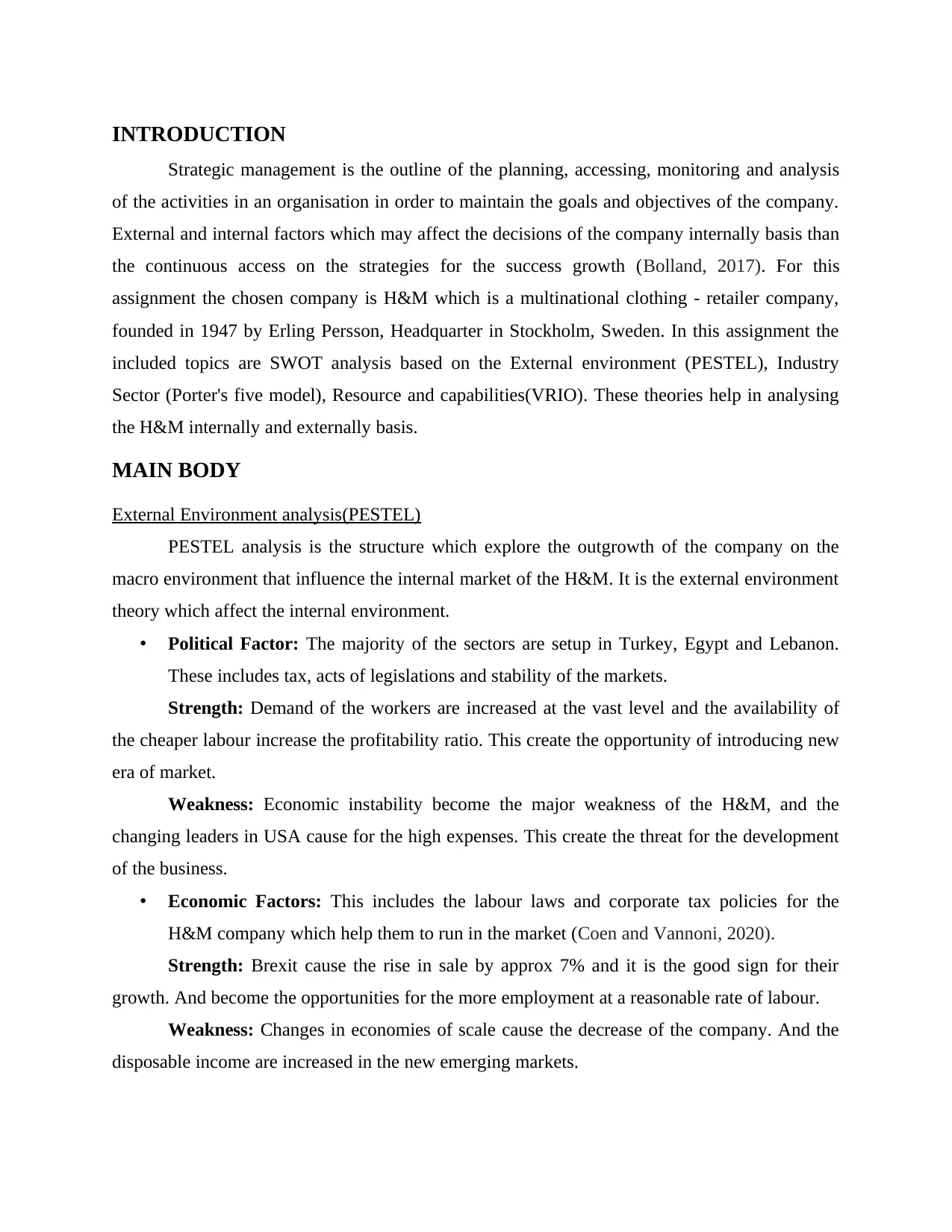
INTRODUCTION
Strategic management is the outline of the planning, accessing, monitoring and analysis
of the activities in an organisation in order to maintain the goals and objectives of the company.
External and internal factors which may affect the decisions of the company internally basis than
the continuous access on the strategies for the success growth (Bolland, 2017). For this
assignment the chosen company is H&M which is a multinational clothing - retailer company,
founded in 1947 by Erling Persson, Headquarter in Stockholm, Sweden. In this assignment the
included topics are SWOT analysis based on the External environment (PESTEL), Industry
Sector (Porter's five model), Resource and capabilities(VRIO). These theories help in analysing
the H&M internally and externally basis.
MAIN BODY
External Environment analysis(PESTEL)
PESTEL analysis is the structure which explore the outgrowth of the company on the
macro environment that influence the internal market of the H&M. It is the external environment
theory which affect the internal environment.
• Political Factor: The majority of the sectors are setup in Turkey, Egypt and Lebanon.
These includes tax, acts of legislations and stability of the markets.
Strength: Demand of the workers are increased at the vast level and the availability of
the cheaper labour increase the profitability ratio. This create the opportunity of introducing new
era of market.
Weakness: Economic instability become the major weakness of the H&M, and the
changing leaders in USA cause for the high expenses. This create the threat for the development
of the business.
• Economic Factors: This includes the labour laws and corporate tax policies for the
H&M company which help them to run in the market (Coen and Vannoni, 2020).
Strength: Brexit cause the rise in sale by approx 7% and it is the good sign for their
growth. And become the opportunities for the more employment at a reasonable rate of labour.
Weakness: Changes in economies of scale cause the decrease of the company. And the
disposable income are increased in the new emerging markets.
Strategic management is the outline of the planning, accessing, monitoring and analysis
of the activities in an organisation in order to maintain the goals and objectives of the company.
External and internal factors which may affect the decisions of the company internally basis than
the continuous access on the strategies for the success growth (Bolland, 2017). For this
assignment the chosen company is H&M which is a multinational clothing - retailer company,
founded in 1947 by Erling Persson, Headquarter in Stockholm, Sweden. In this assignment the
included topics are SWOT analysis based on the External environment (PESTEL), Industry
Sector (Porter's five model), Resource and capabilities(VRIO). These theories help in analysing
the H&M internally and externally basis.
MAIN BODY
External Environment analysis(PESTEL)
PESTEL analysis is the structure which explore the outgrowth of the company on the
macro environment that influence the internal market of the H&M. It is the external environment
theory which affect the internal environment.
• Political Factor: The majority of the sectors are setup in Turkey, Egypt and Lebanon.
These includes tax, acts of legislations and stability of the markets.
Strength: Demand of the workers are increased at the vast level and the availability of
the cheaper labour increase the profitability ratio. This create the opportunity of introducing new
era of market.
Weakness: Economic instability become the major weakness of the H&M, and the
changing leaders in USA cause for the high expenses. This create the threat for the development
of the business.
• Economic Factors: This includes the labour laws and corporate tax policies for the
H&M company which help them to run in the market (Coen and Vannoni, 2020).
Strength: Brexit cause the rise in sale by approx 7% and it is the good sign for their
growth. And become the opportunities for the more employment at a reasonable rate of labour.
Weakness: Changes in economies of scale cause the decrease of the company. And the
disposable income are increased in the new emerging markets.
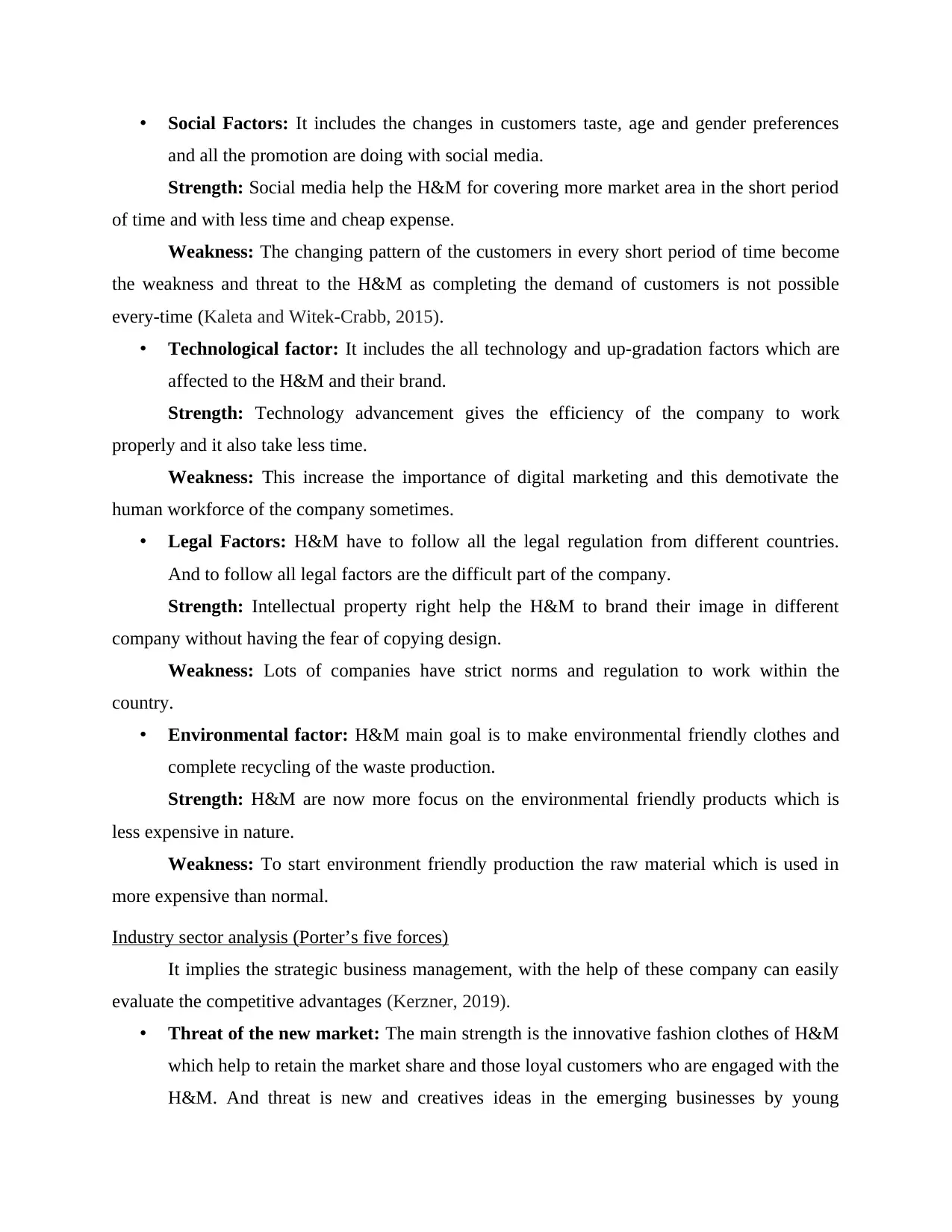
• Social Factors: It includes the changes in customers taste, age and gender preferences
and all the promotion are doing with social media.
Strength: Social media help the H&M for covering more market area in the short period
of time and with less time and cheap expense.
Weakness: The changing pattern of the customers in every short period of time become
the weakness and threat to the H&M as completing the demand of customers is not possible
every-time (Kaleta and Witek-Crabb, 2015).
• Technological factor: It includes the all technology and up-gradation factors which are
affected to the H&M and their brand.
Strength: Technology advancement gives the efficiency of the company to work
properly and it also take less time.
Weakness: This increase the importance of digital marketing and this demotivate the
human workforce of the company sometimes.
• Legal Factors: H&M have to follow all the legal regulation from different countries.
And to follow all legal factors are the difficult part of the company.
Strength: Intellectual property right help the H&M to brand their image in different
company without having the fear of copying design.
Weakness: Lots of companies have strict norms and regulation to work within the
country.
• Environmental factor: H&M main goal is to make environmental friendly clothes and
complete recycling of the waste production.
Strength: H&M are now more focus on the environmental friendly products which is
less expensive in nature.
Weakness: To start environment friendly production the raw material which is used in
more expensive than normal.
Industry sector analysis (Porter’s five forces)
It implies the strategic business management, with the help of these company can easily
evaluate the competitive advantages (Kerzner, 2019).
• Threat of the new market: The main strength is the innovative fashion clothes of H&M
which help to retain the market share and those loyal customers who are engaged with the
H&M. And threat is new and creatives ideas in the emerging businesses by young
and all the promotion are doing with social media.
Strength: Social media help the H&M for covering more market area in the short period
of time and with less time and cheap expense.
Weakness: The changing pattern of the customers in every short period of time become
the weakness and threat to the H&M as completing the demand of customers is not possible
every-time (Kaleta and Witek-Crabb, 2015).
• Technological factor: It includes the all technology and up-gradation factors which are
affected to the H&M and their brand.
Strength: Technology advancement gives the efficiency of the company to work
properly and it also take less time.
Weakness: This increase the importance of digital marketing and this demotivate the
human workforce of the company sometimes.
• Legal Factors: H&M have to follow all the legal regulation from different countries.
And to follow all legal factors are the difficult part of the company.
Strength: Intellectual property right help the H&M to brand their image in different
company without having the fear of copying design.
Weakness: Lots of companies have strict norms and regulation to work within the
country.
• Environmental factor: H&M main goal is to make environmental friendly clothes and
complete recycling of the waste production.
Strength: H&M are now more focus on the environmental friendly products which is
less expensive in nature.
Weakness: To start environment friendly production the raw material which is used in
more expensive than normal.
Industry sector analysis (Porter’s five forces)
It implies the strategic business management, with the help of these company can easily
evaluate the competitive advantages (Kerzner, 2019).
• Threat of the new market: The main strength is the innovative fashion clothes of H&M
which help to retain the market share and those loyal customers who are engaged with the
H&M. And threat is new and creatives ideas in the emerging businesses by young
Secure Best Marks with AI Grader
Need help grading? Try our AI Grader for instant feedback on your assignments.
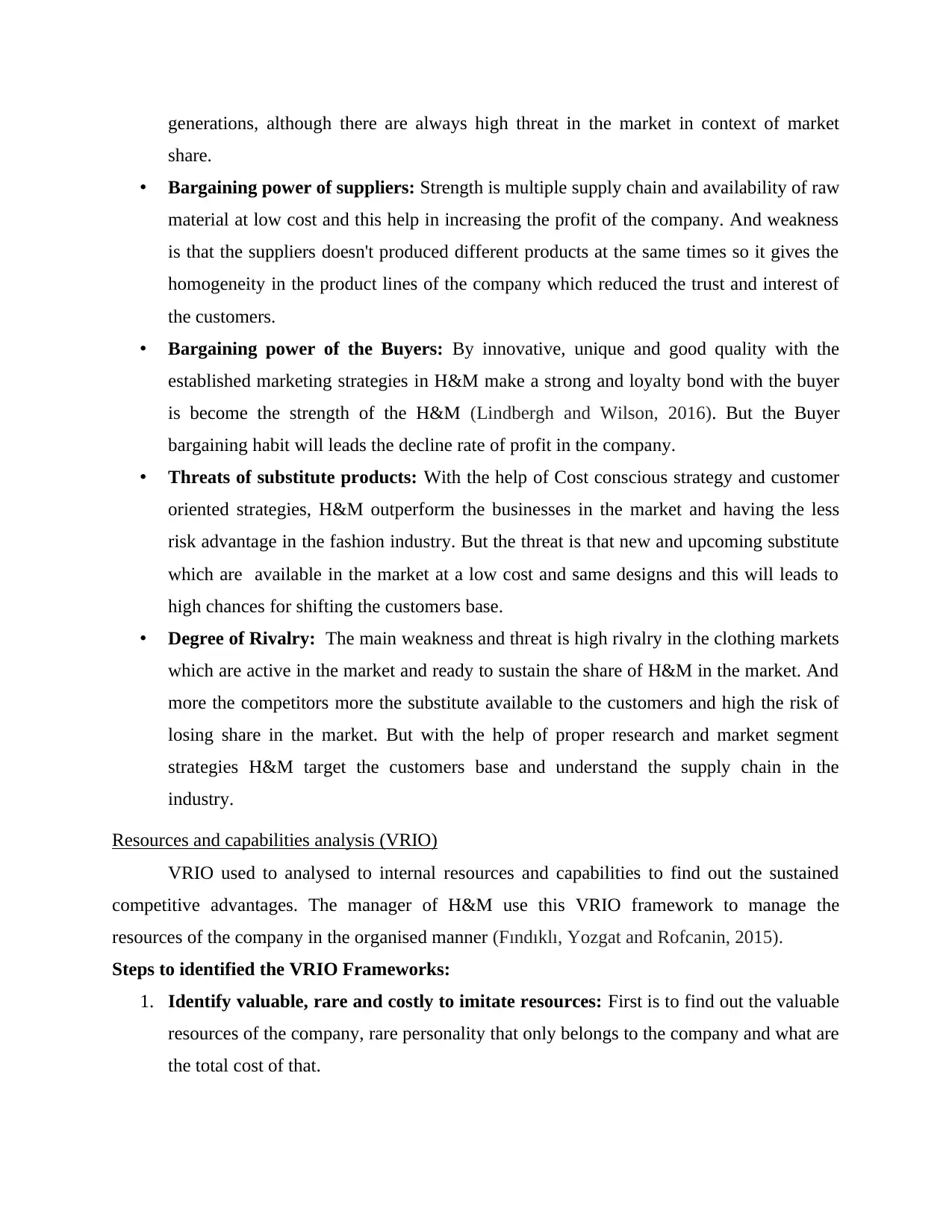
generations, although there are always high threat in the market in context of market
share.
• Bargaining power of suppliers: Strength is multiple supply chain and availability of raw
material at low cost and this help in increasing the profit of the company. And weakness
is that the suppliers doesn't produced different products at the same times so it gives the
homogeneity in the product lines of the company which reduced the trust and interest of
the customers.
• Bargaining power of the Buyers: By innovative, unique and good quality with the
established marketing strategies in H&M make a strong and loyalty bond with the buyer
is become the strength of the H&M (Lindbergh and Wilson, 2016). But the Buyer
bargaining habit will leads the decline rate of profit in the company.
• Threats of substitute products: With the help of Cost conscious strategy and customer
oriented strategies, H&M outperform the businesses in the market and having the less
risk advantage in the fashion industry. But the threat is that new and upcoming substitute
which are available in the market at a low cost and same designs and this will leads to
high chances for shifting the customers base.
• Degree of Rivalry: The main weakness and threat is high rivalry in the clothing markets
which are active in the market and ready to sustain the share of H&M in the market. And
more the competitors more the substitute available to the customers and high the risk of
losing share in the market. But with the help of proper research and market segment
strategies H&M target the customers base and understand the supply chain in the
industry.
Resources and capabilities analysis (VRIO)
VRIO used to analysed to internal resources and capabilities to find out the sustained
competitive advantages. The manager of H&M use this VRIO framework to manage the
resources of the company in the organised manner (Fındıklı, Yozgat and Rofcanin, 2015).
Steps to identified the VRIO Frameworks:
1. Identify valuable, rare and costly to imitate resources: First is to find out the valuable
resources of the company, rare personality that only belongs to the company and what are
the total cost of that.
share.
• Bargaining power of suppliers: Strength is multiple supply chain and availability of raw
material at low cost and this help in increasing the profit of the company. And weakness
is that the suppliers doesn't produced different products at the same times so it gives the
homogeneity in the product lines of the company which reduced the trust and interest of
the customers.
• Bargaining power of the Buyers: By innovative, unique and good quality with the
established marketing strategies in H&M make a strong and loyalty bond with the buyer
is become the strength of the H&M (Lindbergh and Wilson, 2016). But the Buyer
bargaining habit will leads the decline rate of profit in the company.
• Threats of substitute products: With the help of Cost conscious strategy and customer
oriented strategies, H&M outperform the businesses in the market and having the less
risk advantage in the fashion industry. But the threat is that new and upcoming substitute
which are available in the market at a low cost and same designs and this will leads to
high chances for shifting the customers base.
• Degree of Rivalry: The main weakness and threat is high rivalry in the clothing markets
which are active in the market and ready to sustain the share of H&M in the market. And
more the competitors more the substitute available to the customers and high the risk of
losing share in the market. But with the help of proper research and market segment
strategies H&M target the customers base and understand the supply chain in the
industry.
Resources and capabilities analysis (VRIO)
VRIO used to analysed to internal resources and capabilities to find out the sustained
competitive advantages. The manager of H&M use this VRIO framework to manage the
resources of the company in the organised manner (Fındıklı, Yozgat and Rofcanin, 2015).
Steps to identified the VRIO Frameworks:
1. Identify valuable, rare and costly to imitate resources: First is to find out the valuable
resources of the company, rare personality that only belongs to the company and what are
the total cost of that.
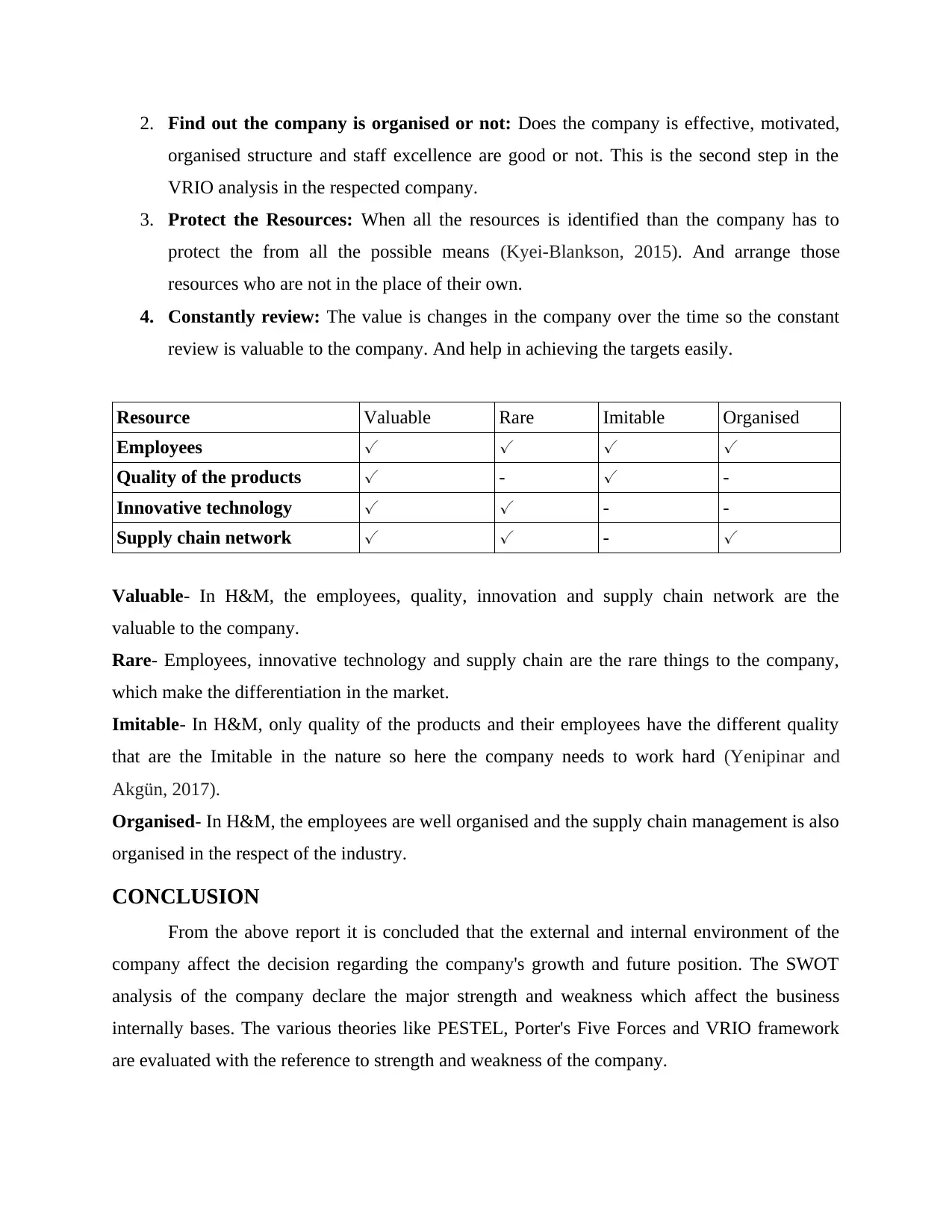
2. Find out the company is organised or not: Does the company is effective, motivated,
organised structure and staff excellence are good or not. This is the second step in the
VRIO analysis in the respected company.
3. Protect the Resources: When all the resources is identified than the company has to
protect the from all the possible means (Kyei-Blankson, 2015). And arrange those
resources who are not in the place of their own.
4. Constantly review: The value is changes in the company over the time so the constant
review is valuable to the company. And help in achieving the targets easily.
Resource Valuable Rare Imitable Organised
Employees ✓ ✓ ✓ ✓
Quality of the products ✓ - ✓ -
Innovative technology ✓ ✓ - -
Supply chain network ✓ ✓ - ✓
Valuable- In H&M, the employees, quality, innovation and supply chain network are the
valuable to the company.
Rare- Employees, innovative technology and supply chain are the rare things to the company,
which make the differentiation in the market.
Imitable- In H&M, only quality of the products and their employees have the different quality
that are the Imitable in the nature so here the company needs to work hard (Yenipinar and
Akgün, 2017).
Organised- In H&M, the employees are well organised and the supply chain management is also
organised in the respect of the industry.
CONCLUSION
From the above report it is concluded that the external and internal environment of the
company affect the decision regarding the company's growth and future position. The SWOT
analysis of the company declare the major strength and weakness which affect the business
internally bases. The various theories like PESTEL, Porter's Five Forces and VRIO framework
are evaluated with the reference to strength and weakness of the company.
organised structure and staff excellence are good or not. This is the second step in the
VRIO analysis in the respected company.
3. Protect the Resources: When all the resources is identified than the company has to
protect the from all the possible means (Kyei-Blankson, 2015). And arrange those
resources who are not in the place of their own.
4. Constantly review: The value is changes in the company over the time so the constant
review is valuable to the company. And help in achieving the targets easily.
Resource Valuable Rare Imitable Organised
Employees ✓ ✓ ✓ ✓
Quality of the products ✓ - ✓ -
Innovative technology ✓ ✓ - -
Supply chain network ✓ ✓ - ✓
Valuable- In H&M, the employees, quality, innovation and supply chain network are the
valuable to the company.
Rare- Employees, innovative technology and supply chain are the rare things to the company,
which make the differentiation in the market.
Imitable- In H&M, only quality of the products and their employees have the different quality
that are the Imitable in the nature so here the company needs to work hard (Yenipinar and
Akgün, 2017).
Organised- In H&M, the employees are well organised and the supply chain management is also
organised in the respect of the industry.
CONCLUSION
From the above report it is concluded that the external and internal environment of the
company affect the decision regarding the company's growth and future position. The SWOT
analysis of the company declare the major strength and weakness which affect the business
internally bases. The various theories like PESTEL, Porter's Five Forces and VRIO framework
are evaluated with the reference to strength and weakness of the company.
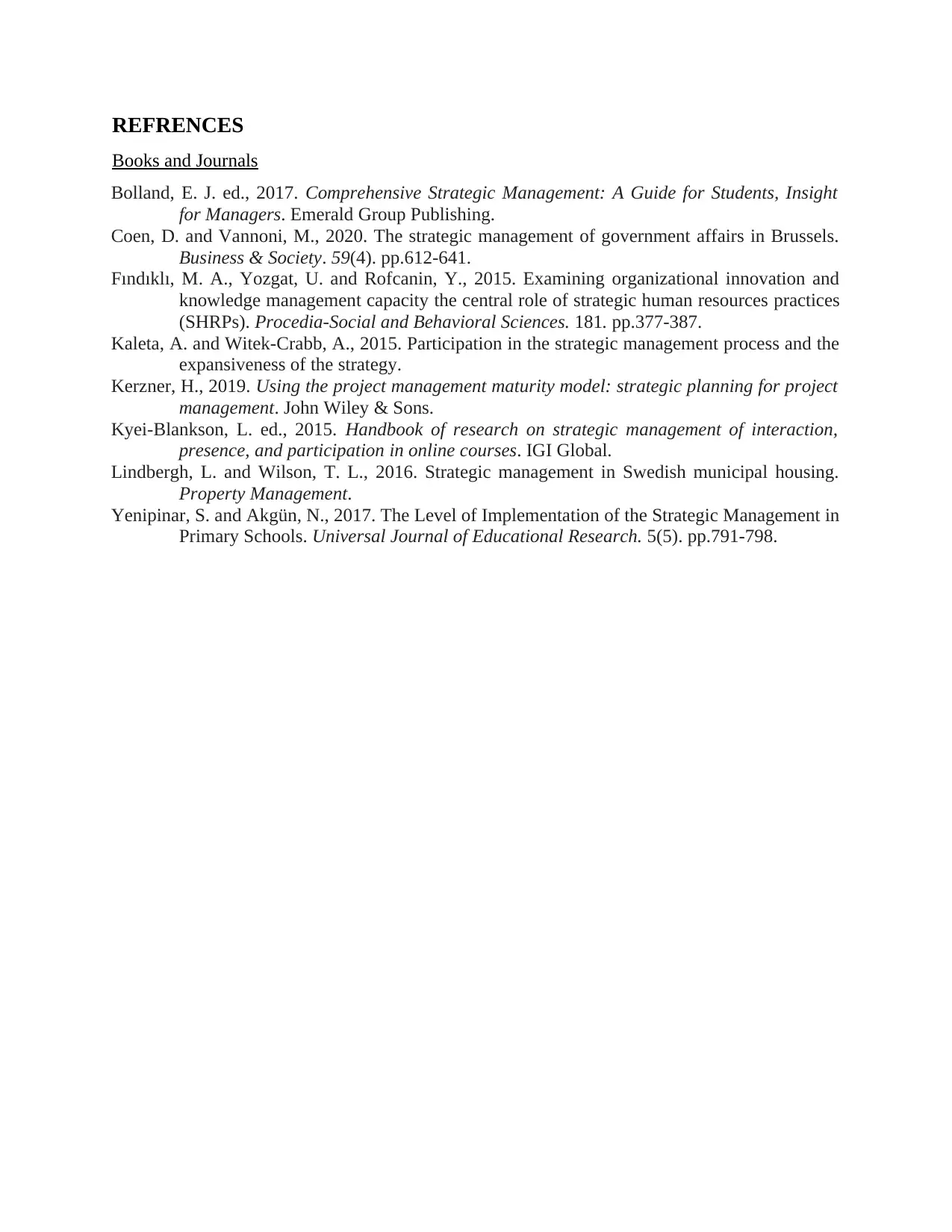
REFRENCES
Books and Journals
Bolland, E. J. ed., 2017. Comprehensive Strategic Management: A Guide for Students, Insight
for Managers. Emerald Group Publishing.
Coen, D. and Vannoni, M., 2020. The strategic management of government affairs in Brussels.
Business & Society. 59(4). pp.612-641.
Fındıklı, M. A., Yozgat, U. and Rofcanin, Y., 2015. Examining organizational innovation and
knowledge management capacity the central role of strategic human resources practices
(SHRPs). Procedia-Social and Behavioral Sciences. 181. pp.377-387.
Kaleta, A. and Witek-Crabb, A., 2015. Participation in the strategic management process and the
expansiveness of the strategy.
Kerzner, H., 2019. Using the project management maturity model: strategic planning for project
management. John Wiley & Sons.
Kyei-Blankson, L. ed., 2015. Handbook of research on strategic management of interaction,
presence, and participation in online courses. IGI Global.
Lindbergh, L. and Wilson, T. L., 2016. Strategic management in Swedish municipal housing.
Property Management.
Yenipinar, S. and Akgün, N., 2017. The Level of Implementation of the Strategic Management in
Primary Schools. Universal Journal of Educational Research. 5(5). pp.791-798.
Books and Journals
Bolland, E. J. ed., 2017. Comprehensive Strategic Management: A Guide for Students, Insight
for Managers. Emerald Group Publishing.
Coen, D. and Vannoni, M., 2020. The strategic management of government affairs in Brussels.
Business & Society. 59(4). pp.612-641.
Fındıklı, M. A., Yozgat, U. and Rofcanin, Y., 2015. Examining organizational innovation and
knowledge management capacity the central role of strategic human resources practices
(SHRPs). Procedia-Social and Behavioral Sciences. 181. pp.377-387.
Kaleta, A. and Witek-Crabb, A., 2015. Participation in the strategic management process and the
expansiveness of the strategy.
Kerzner, H., 2019. Using the project management maturity model: strategic planning for project
management. John Wiley & Sons.
Kyei-Blankson, L. ed., 2015. Handbook of research on strategic management of interaction,
presence, and participation in online courses. IGI Global.
Lindbergh, L. and Wilson, T. L., 2016. Strategic management in Swedish municipal housing.
Property Management.
Yenipinar, S. and Akgün, N., 2017. The Level of Implementation of the Strategic Management in
Primary Schools. Universal Journal of Educational Research. 5(5). pp.791-798.
1 out of 7
Your All-in-One AI-Powered Toolkit for Academic Success.
+13062052269
info@desklib.com
Available 24*7 on WhatsApp / Email
![[object Object]](/_next/static/media/star-bottom.7253800d.svg)
Unlock your academic potential
© 2024 | Zucol Services PVT LTD | All rights reserved.